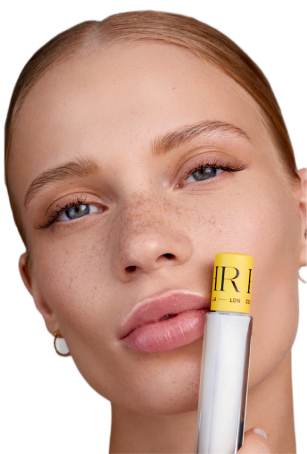The hidden world of endocrine disruptors in beauty
By now, we may have realised that the beauty industry isn't as glamorous and glossy as we are led to believe. The beauty realm is littered with toxins from plastics to synthetics; you only need to glance at the packaging to realise our favourite products are full of toxic chemicals. Beauty is not clean; it turns out that our favourite beauty essentials are wreaking havoc on our hormones. With these concoctions of chemicals in our cosmetic bags, it's no wonder beauty-lovers are left contemplating what we really swipe on our skin.
As brands continue to pump our potions with some pretty gross ingredients, not surprisingly, this can cause adverse effects on our health. Cosmetics are secretly packaged with chemicals that alter our body's carefully regulated hormonal system. This ingredient group is called endocrine-disrupting chemicals (EDCs); these chemicals mimic hormones and create lots of confusion for your body.
The endocrine system is the system that secretes your hormones into the blood through glands. "Hormones act as messengers in the body, responsible for regulating how the body functions," says naturopathic doctor, Dr Danielle Desroche. This involves regulating the sex hormones, estrogen and testosterone and the pancreas gland, which produces insulin. The endocrine system also controls the thyroid hormone, the adrenal gland, and the pituitary gland, which releases growth hormones. The endocrine system regulates sugar levels, growth and development, sexual function, mood and sleep. Essentially a healthy endocrine system is vital for a healthy life.
"Endocrine disruptors is the collective name for chemicals which have been shown to interfere with normal hormone behaviour in our bodies," says CEO, Thalie Martini from the Breast Cancer UK charity. These chemicals, synthetic or natural, alter the natural rhythm of the endocrine system impacting our health. These chemicals trick our hormones into disrupting natural behaviour, such as artificially increasing levels of estrogen. From lipsticks to moisturisers, EDCs are abundant in our cosmetics and unfortunately elude many ingredients list, making them extremely difficult to avoid when browsing the beauty shelves.
These hidden hormone disruptors are linked with varying issues from developmental, reproductive to immune problems. Unfortunately, endocrine disorders are increasing across the globe as we continue to smother ourselves in toxic products. "Many cosmetics and beauty products we use daily contain chemicals which are known or suspected EDCs and have been linked to adverse health effects such as diabetes, thyroid problems and hormonal cancers," follows Martini.
As our bodies pump round unnatural levels of estrogen, it's no wonder women are struggling with infertility, PMS, mood swings and unwanted weight gain. Yikes! "We are exposed to 80,000 toxins each day!" says Dr Desroche. It comes as no surprise then that our health is taking its toll.
"Endocrine disruptors can mimic, block, or interfere with hormones in the body. Hormones are responsible for essential biological processes. When these processes are disrupted or changed, this can lead to cell damage including DNA damage, which can lead to cancer," says Martini. One of the most significant risks from exposure to EDCs is that estrogen dominance can cause hormone-dependent cancers, such as ovarian, breast and uterine in women and prostate cancer in men.
"Endocrine disruptors in cosmetics are readily absorbed into our skin like a sponge, and once absorbed, have a systemic effect on our hormones," says Dr Desroche. And while we continue to smear our skin in cosmetics, it's no wonder "some EDCs build up inside our bodies over time," says Martini. Our exposure to EDCs can be like a ticking time bomb leading to some nasty and unwanted side effects. "This is of particular concern to us as some endocrine disruptors have been shown to influence the development of breast cancer," follows Martini.
These hormone-disruptors are a challenge to avoid because they are prevalent across the world, from house-hold chemicals to food and beauty. "While more research is needed, we know that exposure to even a small amount of endocrine-disrupting toxins can have a negative impact on our health," says Dr Desroche. Our daily routines and products are overflowing with endocrine disruptors. Our exposure to EDCs can add up pretty quickly when we can use up to 15 products a day on our body, which contain hundreds of different and potentially dangerous ingredients. Our cosmetics are filled with dyes, preservatives, parabens and UV filters, all disrupting the natural rhythm of the body.
Our beauty bags contain numerous hormone disruptors, below is a list of these EDCs that you should know, including chemicals that are used widely in lipstick. Yuck! At HIGHR, you can trust that these substances will never be found in our products. As we ingest lipstick, it's essential to detox from these chemicals when we swipe on our favourite shade. If there is only one clean swap you can make, we suggest it should be your lipstick.
Cyclotetrasiloxane, Cyclotetrasiloxane
These skin conditioning agents, also known as D4 and D5, have been labeled as “human endocrine disruptors - strong evidence” but are still on the ingredient listings of best selling concealers and the buzziest lipsticks in the beauty market. Steer clear of these (anything ending in “siloxane”). They’ve been linked to detrimental issues for women including fertility interference and uterine tumors. They have also been proven to be environmentally toxic, bioaccumulating in aquatic life.
Phthalates
Phthalates are found in cosmetics from fragrance to lipsticks and lotions; these elusive EDCs are hard to detect on the ingredients list. Look to see if your product is fragranced, under this label-listing loophole fragrance is an umbrella term to sneak in these hidden hormone-disrupting chemicals. It might smell like roses, but it is far from clean. Research suggests that these chemicals can damage the reproductive system, the lungs and can also be linked to the development of breast cancer.
UV Filters
UV Filters are found in sunscreen and cosmetics which have sun protection in, such as moisturiser or lip balm. These products contain the chemical Oxybenzone, which is not only detrimental to the health of the oceans but can also act as an EDC. Oxybenzone is a chemical you may want to sidestep in your skincare routine as it can impact your thyroid and reproductive functions.
Parabens
Parabens are another hot topic in the beauty world and are commonly found in personal care and cosmetics. Parabens are preservatives to prolong shelf life and are suggested to have estrogenic activity. Parabens are one of the most controversial EDCs due to the damage they can cause and are unfortunately a basic beauty essential when it comes to cosmetic production. This cheap preservative mimics estrogen in the body and can cause hormonally related cancers. Look out for ingredients that contain propyl-, isopropyl-, butyl- and isobutyl-parabens.
Triclosan
Triclosan is an antibacterial compound which is commonly found in soaps, toothpaste and handwashes. This is another chemical to avoid as it can interfere with thyroid hormones and estrogen regulation, leading to unwanted side effects.
Resorcinol
Found in treatments for problems such as acne, eczema and psoriasis, Resorcinol is listed on the European Union's Category one list for endocrine disruptors and has been linked to thyroid disease.
Pesticides
It might be confusing to think of pesticides in our beauty regimes, but while natural beauty is on the rise, we must be aware of how plants are harvested for our products. We should avoid pesticides not only in our cosmetics but also in our food as these pesticides can cause adverse effects on human health.
Plastic
It's argued our most widespread exposure to EDCs is plastic. As they wreak havoc on oceans, wildlife and ecosystems, they also leach harmful chemicals into the surrounding environment. A chemical concern is BPA; this popular endocrine disruptor causes major issues to your health. We recommend reducing your plastic consumption not only for the sake of the planet but for your health too.
"Because our environment is saturated with endocrine disruptors …it's important to choose cosmetics without these hormone-disrupting chemicals. Making thoughtful choices about what we put on our skin can help reduce our overall daily exposure to endocrine disruptors," says Dr Desroche. While the beauty industry continues to seep out these concoctions of chemicals into our products and ultimately onto our skin, we must have more of a say on what ingredients goes on our body. The cosmetic world hides beneath chemical jargon that requires a degree to decipher, every small step towards cleaner choices can significantly help in reducing your exposure to EDCs and taking back control of your health.
We understand it can seem daunting to start your toxic-free beauty routine, so at HIGHR, we recommend taking extra care to areas where we are more vulnerable to exposure. As we can ingest up to seven pounds of lipstick in our lifetime, we suggest you start here. Lipstick should be your first clean swap. At HIGHR you won't find any hidden hormone-disrupting chemicals, just clean, green beauty.
This is HIGHR, lipstick redone with your health and well-being in mind.
- Esme Bourne


